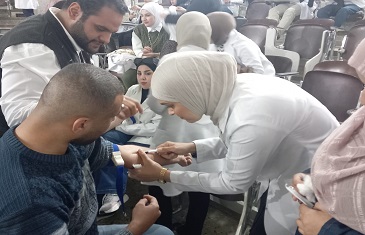
The Rehabilitation and Employment Unit at the College of Science at the University of Baghdad held a workshop entitled “Basics of Blood Drawing”.The workshop aimed to identify the correct method of drawing blood in detail, overcoming dangers resulting from errors and mishandling of patients. It emphasized that blood is one of the important and necessary fluids that carries out critical tasks such as transporting oxygen and nutrients to the body’s cells, as well as removing carbon dioxide, ammonia, waste, and other products.The workshop included learning about the methods of drawing peripheral blood, which involve drawing blood from the capillaries found in the earlobe, fingertip, or heel for newborns, by sterilizing the withdrawal area and recommending leaving the first drop of blood and taking the subsequent drop using special automatic pipettes. It also covered arterial blood withdrawal methods, which the lecturers emphasized are rare except in a few cases such as gas blood tests or studying the difference between glucose levels in arterial and venous blood. Additionally, identify the most important procedures performed in blood tests after being withdrawn from individuals using specialized laboratory equipment.
